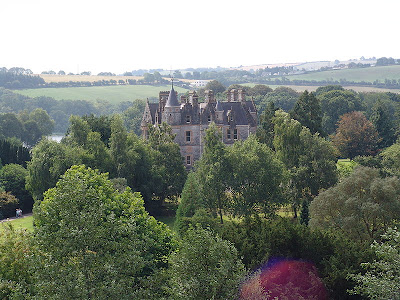skip to main |
skip to sidebar

Fenis Castle is an Italian medieval castle located in the town of Fénis. (Funny how that works...) It is one of the most famous castles in Aosta Valley, and for its spectacular architecture and its many towers and battlemented (Yes, it is a real word.) a walls has become one of the major tourist attractions of the region.

The castle first appears in a document in 1242 A.D. as a property of the Viscounts of Aosta, the Challant family. At that time it probably was a simple keep surrounded by walls. It was from 1320 A.D. to 1420 A.D., under the lordship of Aimone of Challant and of his son Bonifacio of Challant, that the castle expanded to the actual appearance.

Under Aimone’s lordship the castle got its pentagonal layout, the external boundary wall and many of the towers. In 1392 Bonifacio of Challant began a second building campaign to build the staircase and the balconies in the inner courtyard and the prison. He also commissioned Piedmontese painter Giacomo Jaqueiro to paint frescoes on the chapel and on the inner courtyard. Under Bonifacio I the castle reached its greatest splendor: it was a rich court surrounded by a vegetable plot, a vineyard and a garden where the lord and his guests could relax.

The castle belonged to the lords of Challant until 1716, when Georges François of Challant had to sell it to Count Baldassarre Castellar of Saluzzo Paesana (*Snicker*) in order to pay his debts, and for the castle was the beginning of a period of decline. It was turned into a rural dwelling and became a stable and a barn.

In 1895 architect Alfredo d’Andrade purchased it and started a restoration campaign to secure the damaged structures. In 1935 a second campaign by De Vecchi and Mesturino completed the restoration and gave the castle the current appearance. The rooms were also provided with wood period furniture.
The castle is today owned by the Regional Council, which turned it into a museum.

Buon giorno

Burg Hohenwerfen is a castle south of the Austrian city of Salzburg. The castle is majestically surrounded by the Berchtesgaden Alps and the Tennengebirge mountain range. The fortification is a "sister" of Hohensalzburg Castle. Both castles are dated from the 11th century.
It was built between 1075 and 1078 during the Investiture Controversy by the order of Archbishop Gebhard of Salzburg as a strategic bulwark atop a 155 meter rock high above the Salzach valley. In 1931 the fortress, then owned by Archduke Eugen of Austria was severely damaged by a fire and, though largely restored, finally had to be sold to the Salzburg Reichsgau in 1938. After World War II it was used as a training camp by the Austrian Federal Gendarmerie (rural police) until 1987.
Nowadays the bastion, enlarged and renovated several times over the centuries, functions as an adventure castle for its visitors. Among the numerous attractions offered by the fortress are guided tours showing its extensive weapons collection, the historical Salzburg Falconry with the falconry museum as well as a stylish fortress tavern. The historic Falconry Center is a special attraction, offering daily flight demonstrations by various birds of prey.

You might like this, ~A.K.~, the Burg can be seen several times in the background in The Sound of Music, while they are singing Do Re Mi. Neat, huh?
This last picture is the one that made me decide to do a blog post. I took one look at it a literally said in my head, ''Dude epic awesomeness! I wanna own that!''
 Have a wonderful day.
Have a wonderful day.

Blarney Castle (Irish: Caisleán na Blarnan) is a medieval stronghold in Blarney, near Cork, Ireland, and the River Martin. Though earlier fortifications were built on the same spot, the current keep was built by the MacCarthy dynasty, Kings of Desmond, and dates from 1446.

The castle originally dates from before AD 1200, when a wooden structure was built on the site. Around 1210 A.D. this was replaced by a stone fortification. It was destroyed in 1446, but subsequently rebuilt by Cormac Laidir MacCarthy, Lord of Muscry. (Epic name, huh?)

The castle was besieged during the Irish Confederate Wars and was seized in 1646 by Parliamentarian forces under Lord Broghill. However after the Restoration the castle was restored to Donough MacCarty, who was made 1st Earl of Clancarty.
During the Williamite War in Ireland in the 1690s, the then 4th Earl of Clancarty (also named Donough MacCarty) was captured and his lands (including Blarney Castle) were confiscated by the Williamites.
The castle was sold and changed hands a number of times before being purchased by Sir James St. John Jefferyes.
Members of the Jefferyes family later built a mansion near the keep. This house was destroyed by fire however, and in 1874 a replacement baronial mansion - known as Blarney House - was built overlooking the nearby lake.

Well, there is one thing that is always mentioned every time someplace is talking about Blarney Castle. And that is the Blarney Stone. I would really rather not talk about that (Not a pun.) (You will get that statement after you read about the Stone.), but you can read about it here: http://www.travelsinireland.com/castle/blarney.htm

You can read more about Blarney Castle here:
http://www.blarneycastle.ie/history

Dea-lá (Good day.)






















